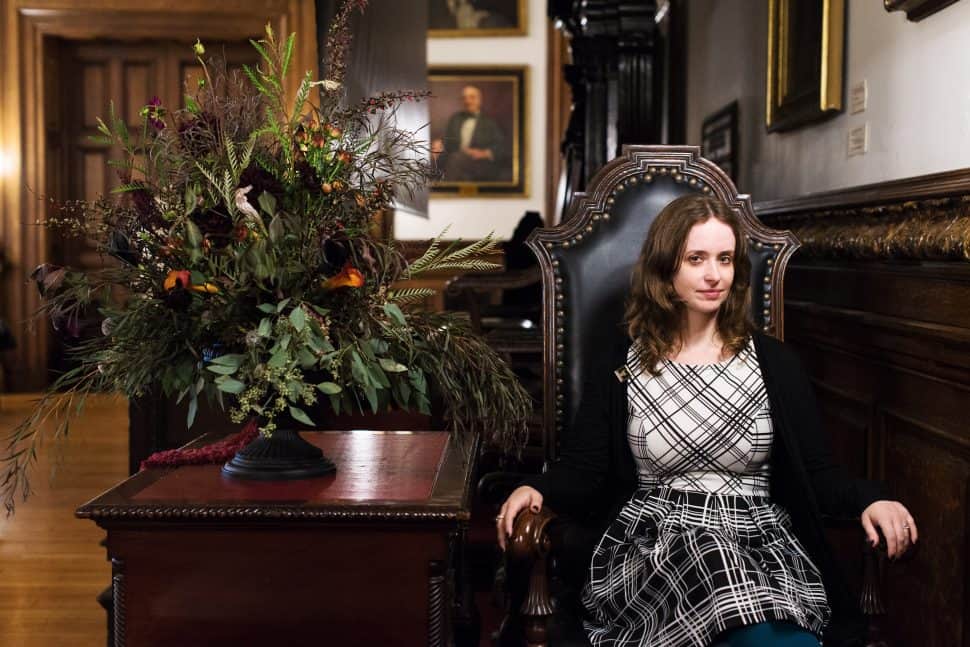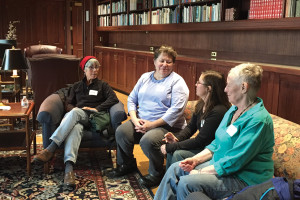
When Megan Rosenbloom meets someone at a cocktail party who inquires about the book she’s working on, she braces for one of two reactions. Her research on the history of anthropodermic books, or books bound in human skin, is by turns fascinating and eerie. “In general people are more intrigued than outwardly horrified because it’s something they’ve never heard about before,” Rosenbloom says. Dark Archives (Farrar, Straus and Giroux, 2020), traces the stories of these books and their intersection with the sometimes gruesome history of medicine and medical ethics.
Rosenbloom, a medical librarian at University of Southern California (USC) and obituary editor for the Journal of the Medical Library Association, is a leader in the “death positive” movement and the Order of the Good Death, a group of “funeral industry professionals, academics, and artists exploring ways to prepare a death phobic culture for their inevitable mortality.” The Order has 15,500 followers on Twitter, where the #DeathPositive conversation is active and ongoing.
She spoke with American Libraries about death positivity, the cultural importance of creepy materials, and how she balances awareness of mortality with joy.
What do you want the public to understand about death positivity and the community you’ve formed around it?
We call ourselves the “death positive” movement, and the phrase death positive is intentionally provocative. Like sex positivity or body positivity, it’s about opening up conversations and trying to break taboos.
When you shut down conversation around difficult topics, people tend to think there’s only one way to do things and anything else is wrong or shameful. When you open up these conversations and explore the history of different cultures, you realize everything surrounding death is culturally relative. And you have a ton of options: There are financial choices that are more sustainable and equitable; environmental choices that might feel more in line with your belief system; rituals you can create that don’t have to fit into one paradigm. When you realize that, you are more empowered to make choices that feel good for you.
There is also a morbid curiosity element. Many people feel shamed for this curiosity and they find community in the death positive movement.
Where did the interest in death come from? How did you come to organize around it?
I’ve always been interested in special collections and rare books, and the ones that I had access to at USC involved medical history, so I started exploring the subject on my own. In the course of learning about medical history, it became clear how much it’s about death. Death is the end of medicine, so the two are intimately linked.
In the US, advances in medicine and changes in social structure have had ripple effects that affect structures of death. We’ve seen sick people moving out of homes and into hospitals, funerals moving into funeral homes, and death being largely handled by professionals. We have fewer interactions with dead bodies; when we do, people don’t know how to handle its psychological effects. It contributes to a culture of death-denial.
I became interested in the ways dead bodies are used for anatomical learning and how the history of medical advancements and training has happened on the backs of these nameless corpses. I started doing lectures about it, which is how I eventually caught the eye of the mortician Caitlin Doughty, founder of the Order of the Good Death.
How did you become interested in anthropodermic books?
I learned about them when I was doing independent research on death and its relationship to library and museum objects and material culture. I met Harvard preservation scientist Daniel Kirby, who was testing the authenticity of suspected anthropodermic books in Harvard’s collection. We compared notes and joined forces with another chemist and also the curator for the Mütter museum, which has the largest confirmed collection of human skin books, to form the Anthropodermic Book Project. Science is helping us determine the authenticity of these physical objects and explore them in ways that were never possible before.
Dark Archives is the historical research part of the project that digs into the stories behind these books, the people who made them, and, if possible, who they were made from. What do they tell us about the history of medicine and medical ethics, how it’s changed over time, the book as a physical object, and class issues in collecting? I also talk to the libraries and museums and collectors who curate these materials today.
Some people might initially be attracted to my book because anthropodermic books are spooky and gross and weird, and that’s fine. But there’s also a bigger lesson here that affects everyone, because we’re all patients.
How do you manage all these projects, both practically and psychologically?
I think having a therapist is a great idea; I recommend that for everyone who can manage it. I am also the mother of a toddler, and that experience completely changed the way I look at my projects. Having a toddler is a super intense circle-of-life experience. There is big joy, but it also brings up a ton of mortality questions.
Part of death positivity—I don’t know if it’s a side effect or maybe the whole point—is that when you engage in mortality and know that life is finite, you tend to value your life more, because you know how precious it is.
What does the death librarian do for Halloween?
I like to joke that Halloween for death positive people is sort of like Christmas for mall Santas. This year’s costume is a family set of skeleton PJs. My daughter is almost 3, so this is probably the final year that I’ll have a say over her costume. I’m also toying with the idea of doing a family photo shoot and using it as a holiday card.
What scary movie will you watch when the little one goes to bed?
The Shining.


